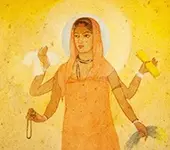Recommended for you
Who was the wife of Jarasandha?

The name of Jarasandha’s wife is not mentioned in Mahabharata or the Puranas.....
Click here to know more..Do you know why Lord Rama did not fight Bali himself directly?
 Click here to know more..
Click here to know more..
Ganeshwara Stuti

shuchivratam dinakarakot'ivigraham balandharam jitadanujam ratapriyam. umaasutam priyavaradam sushankaram namaamyaham vibudhavaram ganeshvaram. vanech....
Click here to know more..
English Topics
Bharat Matha
Click on any topic to open
- 32 Geography in Mahabharata
- 31 Seven Ancient Kingdoms To The West Of Sindhu
- 30 Guru Ram Singh - A Hero Of Indian Freedom Movement
- 29 Bharata Varsha = Indian Peninsula + Eight Islands. Which Are They?
- 28 The Puranic Geography Of Bharata Varsha
- 27 Many Rishis Consider Indra And Varuna As Equals
- 26 Devasura Battle At Balkh
- 25 Vrishakapi The Asura Chief
- 24 The History of alcohol
- 23 Founding of the Asura religion
Please wait while the audio list loads..
30
Ganapathy
Shiva
Hanuman
Devi
Vishnu Sahasranama
Mahabharatam
Practical Wisdom
Yoga Vasishta
Vedas
Rituals
Rare Topics
Devi Mahatmyam
Glory of Venkatesha
Shani Mahatmya
Story of Sri Yantra
Rudram Explained
Atharva Sheersha
Sri Suktam
Kathopanishad
Ramayana
Mystique
Mantra Shastra
Bharat Matha
Bhagavatam
Astrology
Temples
Spiritual books
Purana Stories
Festivals
Sages and Saints
26
15
13
Copyright © 2024 | Vedadhara | All Rights Reserved. | Designed & Developed by Claps and Whistles
